Sweetheart is a term of endearment often applied to a loved one, or a person who demonstrates a significant amount of kindness.

Talinum fruticosum is a herbaceous perennial plant that is native to Mexico, the Caribbean, West Africa, Central America, and much of South America. Common names include Ceylon spinach, waterleaf, cariru, Gbure, Surinam purslane, Philippine spinach, Florida spinach, potherb fameflower, Lagos bologi, sweetheart, and Kutu bataw in Ghana from the Akan language It is widely grown in tropical regions as a leaf vegetable.

Kunzea ericoides, commonly known as kānuka, kanuka, or white tea-tree, is a tree or shrub in the myrtle family, Myrtaceae and is endemic to New Zealand. It has white or pink flowers similar to those of Leptospermum and from its first formal description in 1832 until 1983 was known as Leptospermum ericoides. The flowers have five petals and up to 25 stamens which are mostly longer than the petals.

Talinum is a genus of herbaceous succulent plants in the family Talinaceae whose common names include fameflower. It includes 27 species native to tropical and subtropical regions of the Americas, sub-Saharan Africa, the Arabian Peninsula, Indian subcontinent, and Myanmar. Several species bear edible leaves, and Talinum fruticosum is widely grown in tropical regions as a leaf vegetable. Talinum paniculatum is grown as an ornamental plant.
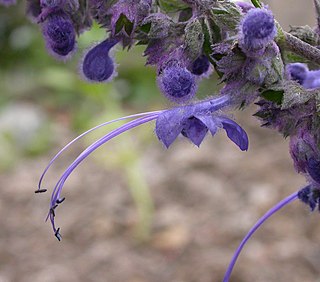
Trichostema is a genus of flowering plants in the family Lamiaceae, which are aromatic herbs or subshrubs. These plants are native to North America. Many plant of this genus which have whorls of small blue flowers are called by the common name bluecurls.
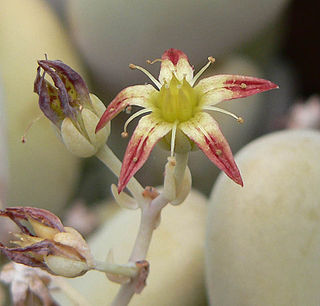
Graptopetalum (leatherpetal) is a plant genus of the family Crassulaceae. They are perennial succulent plants and native to Mexico and Arizona. They grow usually in a rosette. There are around 19 species in this genus.
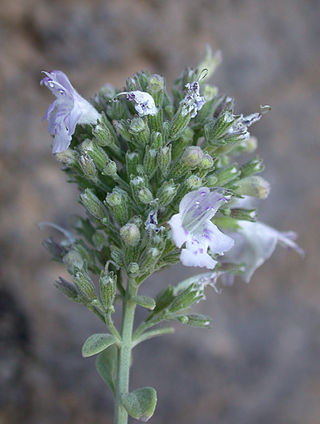
Micromeria fruticosa, commonly known as white micromeria or white-leaved savory, is a dwarf evergreen shrub endemic to the eastern Mediterranean, as well as found in the Balkans. It is a member of the genus Micromeria, in the family Lamiaceae. It is known as zuta levana in today's Modern Hebrew and ashab a-shai in Arabic. The Bedouins, however, call it by the Arabic name, qurniyya, believed to be a cognate of the Hebrew qoranit, an aromatic herb described in the Mishnah. The plant's aromatic leaves are used in making decoctions.

Polyscias fruticosa, or Ming aralia, is a perennial plant, dicot evergreen shrub or dwarf tree, native to India. The plant grows fairly slowly but can reach up to 1–2 meters in height. The leaves are of a dark green pigment, glossy in texture, and are tripinnate and appear divided. Individual leaves vary from narrowly ovate to lanceolate and are about 10 cm long.
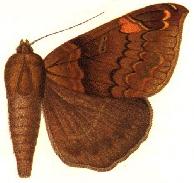
Pindara prisca is a moth of the family Noctuidae first described by Francis Walker in 1858. It is found from Vanuatu and New Caledonia to the southern Cook Islands.
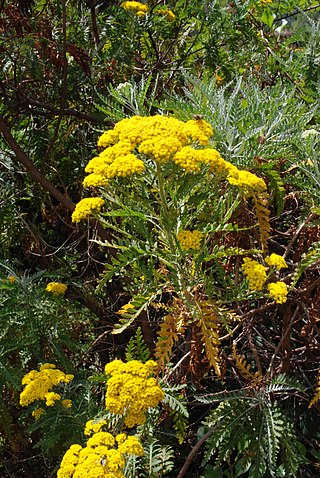
Gonospermum is a genus of flowering plants in the sunflower family.
Trifurcula bupleurella is a moth of the family Nepticulidae. It is found in southern France and the Iberian Peninsula.

Decaspermum humile, commonly known as the silky myrtle, is a tree from Australia and Asia. It can be used as bush food, as indicated by the alternate common name of currant myrtle. The tree features an attractive dark glossy crown. The new pink leaves with silvery hairs are particularly appealing.
Acrocercops inconspicua is a moth of the family Gracillariidae known from Puerto Rico. It was described by William Trowbridge Merrifield Forbes in 1930. The host plant for the species is Citharaexylon fruticosum.

Abutilon fruticosum is a widespread species of flowering plant in the mallow family known by the common names Texas Indian mallow, pelotazo, and sweet Indian mallow. It is native to Africa, southern and southwestern Asia, northern Mexico, and the south-central United States.
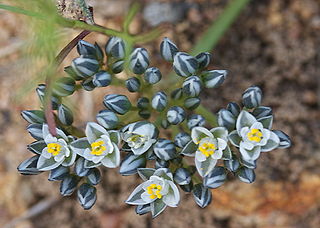
Limeum is a genus of flowering plants. It includes 25 species.
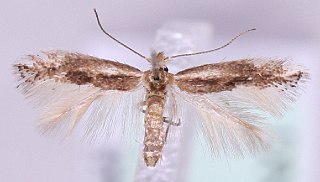
Bucculatrix chrysanthemella is a moth in the family Bucculatricidae. It was described by Hans Rebel in 1896. It is found on the Canary Islands. The species has been introduced in France, Italy, Great Britain and Finland.

Decaspermum is a genus of the botanical family Myrtaceae, first described as a genus in 1776. It is native to China, Southeast Asia, Queensland, and various islands of the Pacific Ocean.

Bupleurum fruticosum or shrubby hare's-ear is a species of flowering plant in the family Apiaceae. It is endemic to the Mediterranean region. It lives in sunny hills, walls and rocky places.

The Fiji tropical dry forests are a tropical dry forest ecoregion in Fiji. The dry forests occupy the leeward northwestern portion of Fiji's two largest islands, Viti Levu and Vanua Levu.
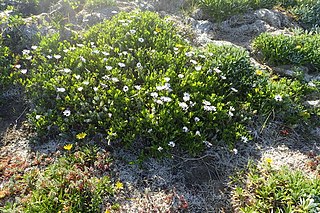
Dimorphotheca fruticosa, is a species of perennial herb native to coastal areas of South Africa. It is commonly known as trailing African daisy, and by its synonym Osteospermum fruticosum.















